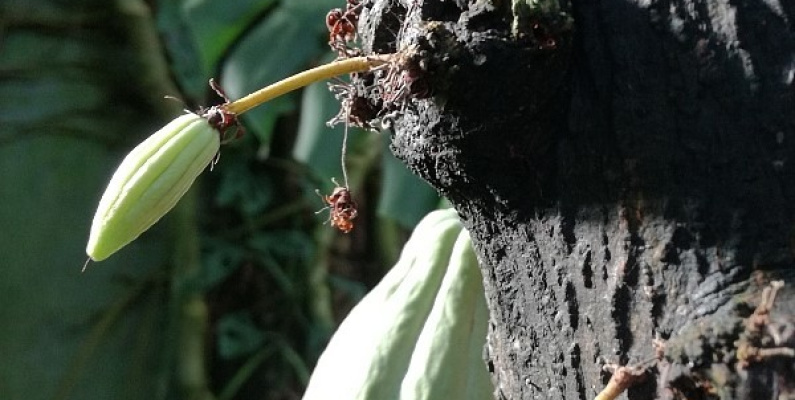
This school holidays, the science engagement team is exploring the delicious science of chocolate! Known as ‘food of the gods’, chocolate, made from the cacao bean, is a favourite treat of many, including me! The chocolate taste we experience is a result of a symphony of different molecules in the cacao that interact with the taste buds on our tongue and the smell receptors in our nose. In fact, chocolate can boast more than 600 different flavour molecules, humbling red wine, with its pitiful 200 or so.

Image credit: Cocoa beans in cocoa pod at El Trapiche, Costa Rica | Aude | Wikimedia Commons | CC BY-SA 3.0
Cacao beans are the seed of the tree Theobroma cacao – literally, ‘cacao, food of the gods’. The cacao flowers grow straight from the trunk or branches of the tree. If they are lucky enough to get the right conditions they might develop into a cacao pod. But this only happens for one in every 500 flowers!
Unfortunately, cacao trees are notoriously difficult to grow. They are uncooperative further than 20 degrees latitude from the Equator, highly susceptible to disease, and can take up to five years to produce just one pod of beans. Because of this, cacao scientists and farmers are interested in finding out how they can breed cacao trees that can grow well, but still produce beans with high quality flavour.

Image credit: Blossom and fruit of a cocoa tree | Chianti | | Wikimedia Commons | CC BY-SA 3.0
Zooming in on cacao beans, we see that, like all living things, they are made of cells; cells that make the delicious chocolate molecules by following the instructions written in their DNA. DNA is found in every living thing, and its molecules contain the instructions to make that particular organism. So, your DNA has the instructions to make you; your cat’s DNA has the instructions to make your cat; and cacao tree DNA has the instructions to make a cacao tree and cacao beans. DNA is made up of a ‘backbone’ and four different nitrogen bases paired together in a very specific way to make base pairs. It is in the sequence of the nitrogen bases that all the instructions are written.
To write these instructions DNA is made up of very long strings of bases – cacao tree DNA has around 420 million bases, while more complex human DNA has about 6 billion. What is incredible is that the DNA alphabet uses only four different letters or bases (A (adenine), T (thymine), G (guanine) and C (cytosine)) to write these instructions, but it uses a very clever system to do so. It uses a code, known as the genetic code, where letters are grouped in sets of three. Each set of three tells the cell to select a different kind of building block called an amino acid. Decipher the code, put the amino acids together, and you get a protein. Proteins are the cell machinery that builds everything required in the cell, and in cacao beans, this means the delicious chocolate molecules.
 Image credit: DNA double helix | Genomics Education Programme | Wikimedia Commons | CC BY 2.0
Image credit: DNA double helix | Genomics Education Programme | Wikimedia Commons | CC BY 2.0
Scientists wanted to figure out the secrets hidden in cacao tree DNA to explain the deliciousness of chocolate. In 2010, two research groups, one backed by Mars and the other by Hershey’s, ‘sequenced’ the DNA (that is, worked out the sequence of all the letters in the DNA) of two different species of cacao tree. The researchers discovered many of the genes that are involved in making the flavour molecules, as well as genes that help the trees fight disease.
Having this information helps with breeding trees that have higher yields, grow faster and are more resistant to disease, but don’t lose any of that high quality flavour that chocolate-lovers crave. Good news for chocoholics everywhere!
If you want to learn more, join us at the Otago Museum between 11am and 2pm, until Friday 21 July, to decode cacao DNA at the ‘Cacao Bean Gene Detectives’ workshops, or find out how we use our senses of smell, taste and texture to enjoy chocolate at our pop-up science shows.
